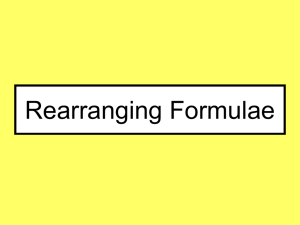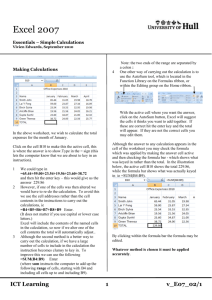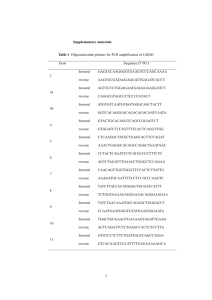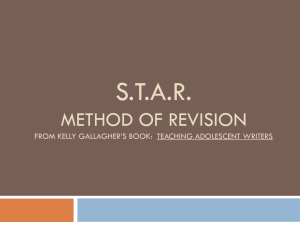Rearranging Formulas
advertisement
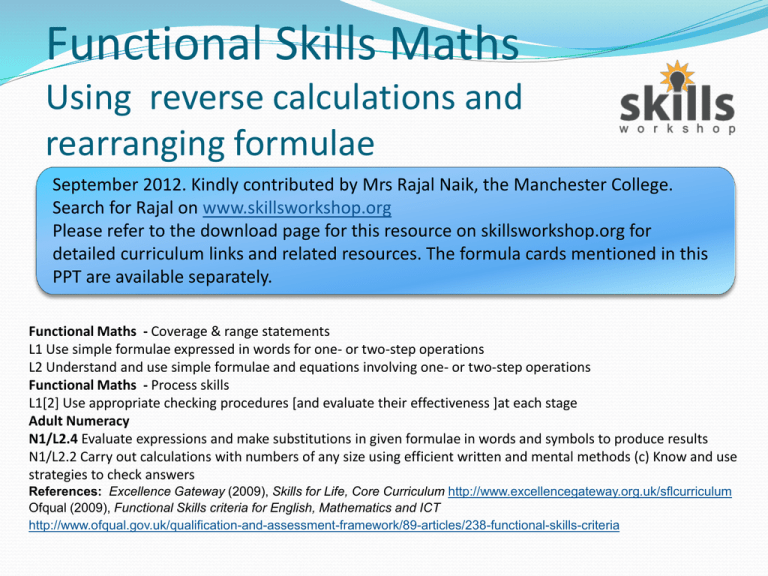
Functional Skills Maths Using reverse calculations and rearranging formulae September 2012. Kindly contributed by Mrs Rajal Naik, the Manchester College. Search for Rajal on www.skillsworkshop.org Please refer to the download page for this resource on skillsworkshop.org for detailed curriculum links and related resources. The formula cards mentioned in this PPT are available separately. Functional Maths - Coverage & range statements L1 Use simple formulae expressed in words for one- or two-step operations L2 Understand and use simple formulae and equations involving one- or two-step operations Functional Maths - Process skills L1[2] Use appropriate checking procedures [and evaluate their effectiveness ]at each stage Adult Numeracy N1/L2.4 Evaluate expressions and make substitutions in given formulae in words and symbols to produce results N1/L2.2 Carry out calculations with numbers of any size using efficient written and mental methods (c) Know and use strategies to check answers References: Excellence Gateway (2009), Skills for Life, Core Curriculum http://www.excellencegateway.org.uk/sflcurriculum Ofqual (2009), Functional Skills criteria for English, Mathematics and ICT http://www.ofqual.gov.uk/qualification-and-assessment-framework/89-articles/238-functional-skills-criteria Rearranging Formulas and the use of Reverse Calculations by Mrs Rajal Naik Introduction In functional skills exams you may be asked to check your own answers using reverse calculations make any part of the formula the subject The following presentation will demonstrate both of these topics. Terminology What is the subject of the formula? This is the main term you are trying to find the value for. E.g. in area = length x width, area is the subject. Finding a Part of the Formula When we want to find a part of the formula e.g. in A=L x W, we need to rearrange it, to find the length i.e. make the length the subject of the formula , we do this in the following way. AREA = LENGTH X WIDTH Now use the cards to work out the Area or perimeter of the rectangles or squares. What is reverse calculation Reverse calculations are used to check your own answer, by reversing each step in the calculation. When you move a positive value to the other side of the equals sign, the value becomes negative and vice versa. When you move a multiplication to the other side of it, the value becomes a division and vice versa. Rules when rearranging the formula ( reverse calculation - easy method) The following examples demonstrate this. Remember both side of the equation must balance at the end, If your answer is correct. 48 8 = 6× 35 - 9 = 26 = + Rules related to rearranging the formula (the harder but correct method) When we rearrange a formula, we can work out what the reversed value of each bit of the sum will be, by either adding, taking away, dividing or multiplying both sides of the formula to preserve the equation. The following formula for circumference demonstrates this, when making the d, the diameter the subject. C = πd ÷ both sides by π C ÷ π π So C =d π Cancel each other out Now try these Reverse the following equations to make 5 the subject in both of the following equations. 1) a) 7 x 5 = 35, so 5 =? b) 30 ÷ 5 = 6, so 5=? 2) Area = length x width. If area to be plastered is 38m2 and length of plasterboard is 9.5 m what is the width of the plasterboard? Rearrange the formula to find the width. Use the cards to help you rearrange the formula.

